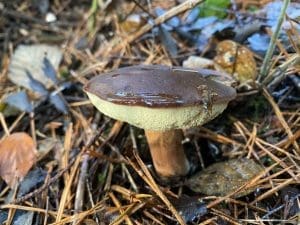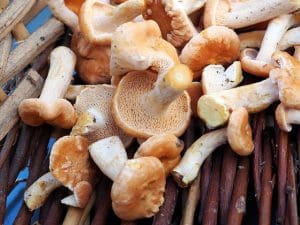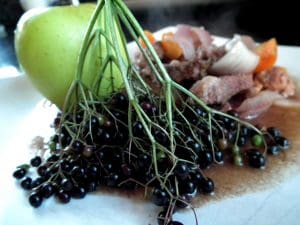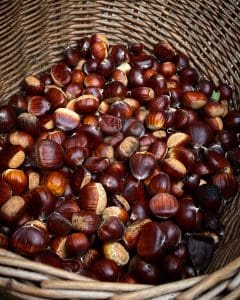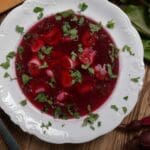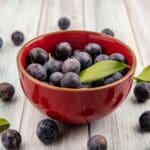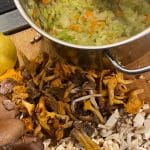Foraging in September is brilliant, September marks the end of summer and the beginning of autumn, it’s the month for berries, nuts and seeds. The wetter weather also marks the beginning of ‘mushroom season’ and you’ll see fungi springing up almost everywhere you look.
So what can you forage in September? Here are our top five picks for the month.
Hawthorn berries
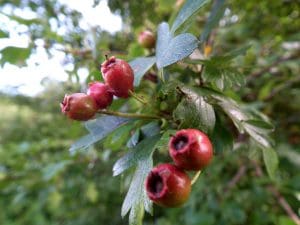
When we’re foraging in September I find there’s quite a few in between ingredients, they’re not quite in one stage but not quite in another, lucky for us hawthorn berries have ripened up and are ready for eating – this is towards the end of September though.
An underused berry in my opinion, they are flavoursome and packed full of goodness. Lots of guidebooks recommend waiting until after the first frost but I tend to pick them as soon as they are ripe and freeze them for a couple of days to increase their sweetness. Once defrosted they’re really versatile and can be used in sweet and savoury recipes.
Click here for the ID guide for Hawthorn.
Elderberries
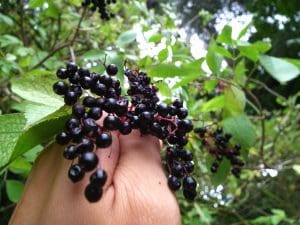
One of the most nutritious berries that we end up foraging in September, they are high in antioxidants and vitamins that boost your immune system, reduce inflammation and protect your heart, they also taste pretty good too! Use them in pies, crumble, jellies and liquors. While you’re picking them keep your eyes open for the Jelly Ear mushroom, they’re normally at their most striking now.
Click here for the ID guide for Elder.
Acorn
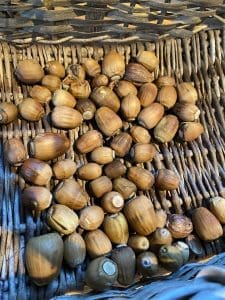
A lot of people are under the illusion that acorns are toxic when in fact they are an incredible, edible resource. They can be used to make flour and coffee alternatives or used as you would any other nut. They are high in tannic acid which needs to be ‘leached’ out first which is simple but can be a bit time consuming.
Click here for the ID guide for Oak.
Sweet chestnut

LIke acorns are an incredible edible nut, not to be confused with Horse Chestnut or conkers that are toxic but surprisingly can be used to make soap. Sweet chestnuts are traditionally roasted on an open fire at Christmas time but they can also be used to make flour, coffee, porridge and beer.
Click here for the ID guide for Sweet Chestnut.
Hedgehog fungus

These little mushrooms could be my all-time favourites, depending on the year we don’t always end up foraging in September for these and will find them later in the year, however, September is often a good bet for them.
I love their flavour and texture and they keep a lot longer than many other species. They are quite common in woodlands from September until November and are very beginner-friendly. The name comes from the ‘spines’ that cover the underside of the mushroom and are a key ID feature to look for.
Click here for the ID guide for Hedgehog fungus.
Recipe of the month – Elderberry Pontack sauce
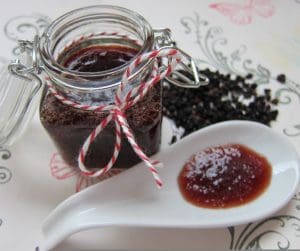
Elderberry Pontack sauce might be one of those things you’ve never heard of, but once you’ve tasted it you’ll never forget it. It’s difficult to describe but it’s a bit like if Worcestershire sauce, port & ketchup had a little party under a fruiting elder tree and created their own off-breed super sauce.
It goes specifically well with earthy flavours, think salt-baked beetroots or venison burgers, I often use it as a straight substitute as a more adult version of ketchup.
Ingredients:
- 400g elderberries, try to remove as much berry from the stalks as possible – I use a fork to help with that.
- 200ml white apple cider vinegar
- 200ml balsamic vinegar
- 100ml Worcestershire sauce (or similar like hendersons)
- 2 red onions, peeled & diced
- 150g brown sugar
- 1 thumb ginger
- 1 tsp hogweed seeds or another spice of your liking for example cumin or coriander
Method:
- Put all of the ingredients apart from the sugar in a slow cooker & allow it to stew over 4 hours (add a little extra liquid if it looks like it may dry out but it shouldn’t)
- After a couple of hours use a potato masher to mash everything up and get as much of the juice out as possible.
- Strain through a sieve or muslin cloth to remove and thick or woody bits and the fruit
- Pop in a pan and bring to a simmer & add the sugar stirring until it’s nicely dissolved.
- Bottle & enjoy
- You can keep it on the pan for a bit if you’re after a thicker, more sticky sauce – that’s up to you.
- It can be eaten straight away but it’s best left to mature for a week or two if you can resist it.
If you don’t want to make your own this pontak sauce is to buy and is my fave 🙂
Click here for more Autumn recipes.
What to Forage in August.
Traditionally the first of August marks Lammas day which signals the start of the harvest season which is perfect for foraging in August. The Anglo-Saxon name for August was Vueod-Monath which means weed month, as this is the time when they grow most abundantly, making it a particularly good month for foraging, gathering and preserving.
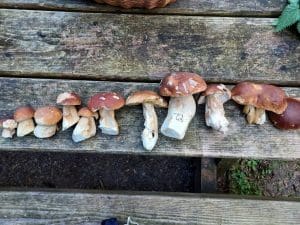
What to forage in October.
